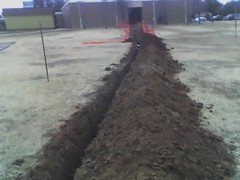The Lubbock Independent School District is laying a fiber optic cable to our local elementary school, Murfee Elementary.
I may be naive about this, but I think establishing fiber optic Internet cable connections to all our schools, both urban and rural, is critically important. The future of education will include digital curriculum increasingly accessed via the Internet. Schools that continue to experience bandwidth poverty (which includes over half the state of Texas currently, whose districts are connected to their regional service center with just a single T-1 connection) will be on the losing side of the digital bandwidth divide.
We took a few photos of the trench and conduit materials across the street this morning, and I uploaded them as a new Flickr photo set. I do not know how much bandwidth will be initially utilized by the school from the fiber bundle once it is connected, but I am sure it will be a substantial increase from the current T-1 connectivity the school has had up to this point.
My article from last fall (published just online, not yet in print) “Digital Curriculum and The Last Mile: Providing Curricular Flexibility and Limitless Bandwidth” focuses on this issue. These two paragraphs from the conclusion of the article will give you a taste of the overall message:
Sadly, as Larry Cuban documented in “Oversold and Underused: Computers in the Classroom,” these types of non-traditional, disruptive uses of educational technology tend to be few and far between in today’s schools (2001). Much more common are the uses of PowerPoint to lecture and attempt to transmit content from the mouth of the teacher into the mind of the student, and the use of web browsers to harvest text and graphics for use in fairly traditional school reports.
Several things are needed to change this present reality, and the most obvious are the choices teachers make about how to use available technology. But a second and equally important issue that needs to change is available bandwidth at school, and the ways district IT departments support or obstruct teachers in their desired uses of that bandwidth. For the majority of schools today, available bandwidth is in short supply, and this makes both interactive videoconferencing as well as bandwidth required for one to one laptop initiatives which will soon be upon all of us completely unrealistic. This must change.
I am VERY glad to see our local school district laying fiber optic cable to our elementary school. Unfortunately, my perception is that many rural areas are NOT close to being in a similar situation. The question is, what will it take to bring robust, fiber-optic level bandwidth to ALL schools across the United States? The economic cost of doing this is still prohibitive for many smaller, rural districts I think. It appears state legislatures need to step in to make this dream and need a reality.
Even if the streets of cyberspace are paved with autobahn gold (perhaps a metaphor for fiber optic connections) we still won’t see changes in educational experiences and outcomes unless teachers and principals change their predominant educational philosophy from a content-transmission based model to one which values project based learning, solving ill-defined problems, and in-depth learning. Even though cost requirements may appear to be different, this is a much more challenging prospect than digging trenches and laying conduit for fiber cables.


Comments
One response to “Fiber to the schoolhouse”
I don’t think you’re wish for every school to have fibre optics is out of the box at all. It’s essential if the US is not going to fall behind small countries like Scotland where ALL the schools have fibre optics and VERY high speed internet access, plus a whole suite of tools (Video Conferencing, shared e-Whiteboards, VLEs). Well, we get all that from September, but at least we will ALL have it.